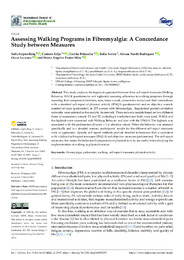Título :
Assessing Walking Programs in Fibromyalgia: A Concordance Study between Measures |
Autor :
López Roig, Sofía 
ECIJA-GALLARDO, Carmen 
Peñacoba, Cecilia 
Ivorra, Sofía
Nardi-Rodríguez, Ainara 
Lecuona, Oscar 
Pastor-Mira, María Ángeles  |
Editor :
MDPI |
Departamento:
Departamentos de la UMH::Ciencias del Comportamiento y salud |
Fecha de publicación:
2022-03-04 |
URI :
https://hdl.handle.net/11000/33516 |
Resumen :
This study analyzes the degree of agreement between three self-report measures (Walking
Behavior, WALK questionnaire and logbooks) assessing adherence to walking programs through
reporting their components (minutes, rests, times a week, consecutive weeks) and their concordance
with a standard self-report of physical activity (IPAQ-S questionnaire) and an objective, namely
number of steps (pedometer), in 275 women with fibromyalgia. Regularized partial correlation
networks were selected as the analytic framework. Three network models based on two different
times of assessment, namely T1 and T2, including 6 weeks between both, were used. WALK and
the logbook were connected with Walking Behavior and also with the IPAQ-S. The logbook was
associated with the pedometers (Z-score > 1 in absolute value). When the behavior was assessed
specifically and in a detailed manner, participants’ results for the different self-report measures
were in agreement. Specific self-report methods provide detailed information that is consistent
with validated self-report measures (IPAQ-S) and objective measures (pedometers). The self-report
measures that assess the behavioral components of physical activity are useful when studying the
implementation of walking as physical exercise.
|
Palabras clave/Materias:
fibromyalgia
pedometer
walking
self-report measures
physical activity |
Área de conocimiento :
CDU: Filosofía y psicología: Psicología |
Tipo de documento :
info:eu-repo/semantics/article |
Derechos de acceso:
info:eu-repo/semantics/openAccess
Attribution-NonCommercial-NoDerivatives 4.0 Internacional |
DOI :
https://doi.org/10.3390/ijerph19052995 |
Publicado en:
International Journal of Environmental Research Public Health 2022, 19(5), 2995 |
Aparece en las colecciones:
Artículos Ciencias del Comportamiento y Salud
|

 La licencia se describe como: Atribución-NonComercial-NoDerivada 4.0 Internacional.
La licencia se describe como: Atribución-NonComercial-NoDerivada 4.0 Internacional.
.png)